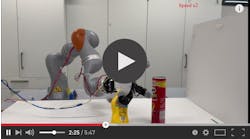A new generation of point artificial intelligence solutions will prove themselves in the near future.
They’ll build new trust, urgency, and understanding of what AI actually is and just how much it can deliver.
Voice-driven solutions will lead the charge. And we’ll see pick-and-place robots in smart warehouses delivering a major competitive edge, as companies advance their use of Robotic Process Automation.
Here are three key predictions for AI in manufacturing.
Prediction #1:
50% of all manufacturing companies will be using AI in some form by the end of 2021.
For many businesses, targeted AI solutions are already here. According to an IFS survey of 750 manufacturing companies across 16 countries, 81% of manufacturers have already embraced some type of transformational technology to digitize business processes. AI realism will spread in the coming years because of its ability to interpret the massive amounts of data that IoT devices provide, allowing more accurate forecasting to take place and better predictive maintenance routines.
A big stumbling block for AI has always been the term ‘AI’ itself. It misleads many manufacturers, suggesting a large end-to-end system. AI is already used to support enterprise-wide business decisions in what-if planning scenarios. In reality, ‘AI’ is more often a collection of targeted technologies, from natural language processing to vision identification to chatbots to analytics to automation – each with its own strengths and applications. What they all share is the intelligence factor: a high degree of accuracy and an incredibly fast ability to learn from their mistakes.
When thinking of AI, it’s important to remember that you can’t “implement AI” any more than you can “implement the internet.” Before you initiate any project, you must figure out your“why.” What exact business goal or target are you aiming for? What exactly do you want to improve or enhance? The more targeted your objectives are, the more competitive and transformative your results will be.
This percentage was based on two factors: the rate of adoption of digital transformation in general within the business and the advantages that robots give (no lunch breaks, lights-out manufacturing, etc.).
Prediction #2:
25% of manufacturing planners will be talking to their systems by the end of 2020.
AI solutions are smarter and more eloquent than most of us realize. A year ago, a major AI customer survey found that two-thirds of people who said they had never used AI actually had, through chatbots. The quality was so high that the chatbots had been indistinguishable from human speech. The same survey found 84% of respondents were comfortable using voice-activated AI at home, in the form of Alexa, Siri or Home. And if simplicity, speed, and accuracy are crucial consumer benefits, imagine what they could do on a manufacturing line.
BMW’s smart integration of Alexa into its models in March 2018 was widely applauded. And rightly so. The integrated voice activation went beyond skin-deep, adding layers of service and performance capability to the driving experience. What’s less well-known is that voice-activated solutions are also already being used on the production side of the automotive sector.
In Japan, one of our customers, NEC, which manufactures servers and mainframe computers, is using voice-activated solutions in their order-picking process, where line personnel give spoken instructions and their order is instantly created. This moves us swiftly on to…
Prediction #3:
Pick-and-place robots will put away 25% of manufactured goods by the end of 2020
Robots on the production line have been essential for decades. But what kind of savings will AI-enabled robots deliver in the warehouse?
With the adoption of digital transformation and the advantages that robots offer, they’re likely to trim costs and give companies a competitive edge.
When Amazon made headlines with their smart warehouses staffed with swift, inexhaustible robots, it became clear that robots raised the performance and savings bar considerably. Robots do not need lighting and work at relatively low temperatures, so energy costs plummet. There are no time or weight limits on breaks, shifts or loads. And the flexibility, fluency, reach, and economy of robot-driven picking and placing means no wasted time or effort—and better utilization of space.
Robotic picking in rack-supported warehouse structures is nothing new to some sectors, but when we combine intelligence and robotics, we see an unprecedented ROI. A report from the London Business School shows that companies save little with robotics alone, but those that retool business processes with AI and robotics combined have seen cost savings as high as 30 to 70%.
While this technology is still in its early stages, cost savings are increasingly difficult to predict—that’s why upfront expenses like robot maintenance and repairs must be taken into consideration.
Lights-out warehouses may be some years away. But it has begun. At IFS, we’re already seeing innovative partner companies beginning work with automated warehouses: Heavy parts that may once have required a team of workers can now be plucked off the shelf by a robot.
2019 will see the technologies become more targeted and more project-driven—more focused on achieving small, concrete improvements that lead to big changes.
Like a more accurate demand forecast that will have a larger impact on the whole business than just more efficient production scheduling. There is only so much a company can do to improve the manufacturing process—that’s why the feed into production is vital. In the case of one company with a large number of service calls and emails each month, the introduction of a chatbot reduced calls by 35% and improved both employee and customer satisfaction.
Companies are beginning to realize that they actually don’t need to “climb an AI mountain.” They just have to keep taking the right, small steps to reach new heights.











